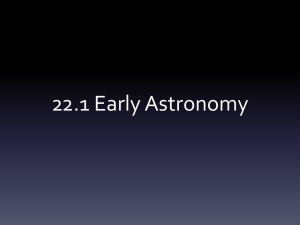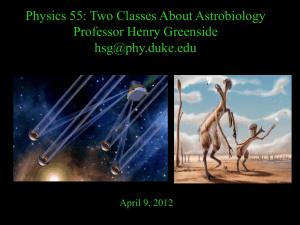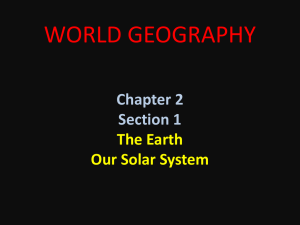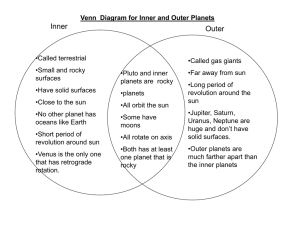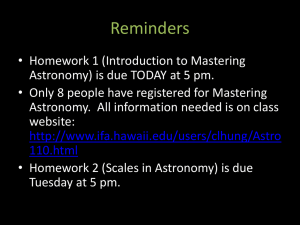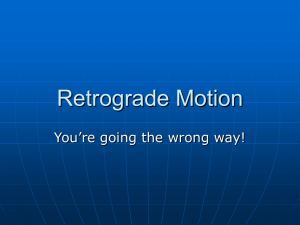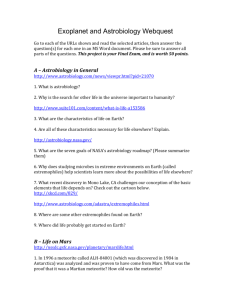History Of Astronomy
advertisement
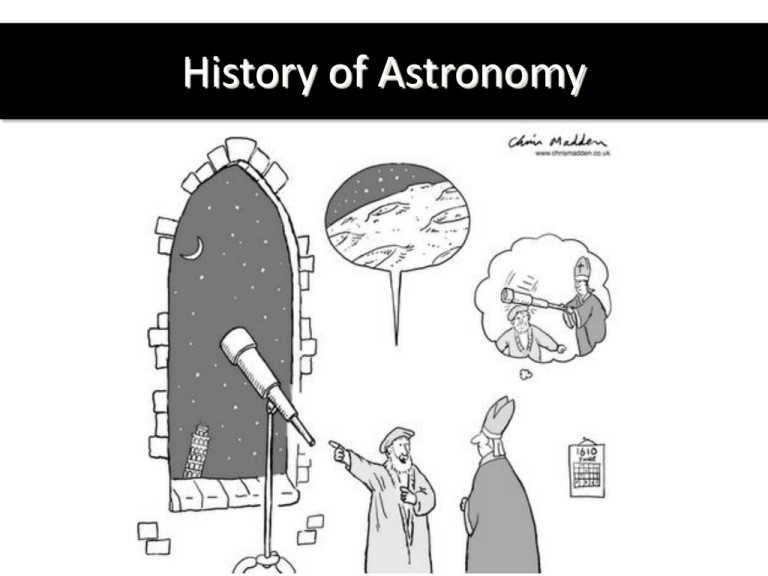
History of Astronomy Question of the Day Question: What is your grade in ESS? Answer: … … … Frequently Missed Test Questions Our galaxy is classified as a(n) a. Irregular galaxy b. Elliptical galaxy c. Spherical galaxy d. Spiral galaxy Frequently Missed Test Questions Light traveling towards you will be red shifted due to the Doppler Effect. a. True b. False Frequently Missed Test Questions Spiral galaxies often appear bluish due to an abundance of a. Old stars b. Black holes c. Young stars d. White dwarfs Want a Higher Test Grade? • Test corrections – During tutorial – May use anything EXCEPT phone & other people; use test dividers – 1/3 of a point back per question – Grab your scantron and sign out a test – Last day: Thursday, 10/24 History of Astronomy Or, how did we build our current understanding about the solar system? An interest starts…. Since ancient times, astronomers observed the skies, watching the paths of the planets and stars Observations of Mars started philosophers and astronomers trying to explain the motion of the planet across the sky An Interest starts… Mars usually moves from east to west compared to the stars, but occasionally it changes directions (retrograde motion) Which step of the Scientific Method is this? A. B. C. D. Hypothesis Drawing Conclusions Observing/ Stating a problem Experiment Aristotle’s Hypothesis Very influential Greek philosopher Lived approximately 350 B.C. Thought the universe consisted of concentric spheres Aristotle’s Hypothesis Aristotle believed the universe was geocentric. This means that A. B. C. D. The earth was at the center The sun was at the center A black hole was at the center A galaxy was at the center Ptolemy’s Hypothesis QuickTime™ and a GIF decompressor are needed to see this picture. Approximately 150 A.D Geocentric Model Lived in Egypt, influenced by Greeks Planets moved on a small circle that moves on the circumference of the planet’s orbit Model lasted for over 1000 years Ptolemey’s Model Copernicus’ Hypothesis 1473 - 1543 Revived an old Greek heliocentric model. This model was centered around A. B. C. D. The earth The sun A black hole A galaxy Only slightly better predictions of planet’s positions because orbits were still perfect circles Galileo Galilei 1600 Used telescope to observe A. B. C. D. UFOs The Sun moons of Jupiter Life on Mars Confirmed Copernicus’ findings House arrest for beliefs Church finally apologized in 1970’s Tycho Brahe Eccentric Danish nobleman, astronomer to the Danish King Had a silver nose from a duel Geo-Helio-Centric model Hired a young mathematician to help with observations and calculations- Kepler. When Tycho dies, Kepler took research and precise measurements from him. Brahe’s Model Kepler’s Hypothesis Used Brahe’s data Correctly modeled the orbit of the planets but had difficulty believing his own work Kepler’s Three Laws Law #1: All planets orbit the Sun in ellipses. Before Kepler, everyone assumed that planetary orbits were circular. By studying Mars, Kepler realized that this was not true. Law #2: Planets move faster when they are closer to the Sun and slower when they are further away. The imaginary line between the planets and the Sun sweep out equal areas in equal times. Law #3: The further the distance from the Sun, the longer the “year.” The period of a planet’s orbit around the Sun is determined by its distance from the Sun. http://www.lasalle.edu/~smithsc/Ast ronomy/retrograd.html p. 550, #1-5 1. 1. List the planets in order of their distance from the sun. The planets in order of their distance from the sun are Mercury, Venus, Earth, Mars, Jupiter, Saturn, Uranus, and Neptune. [Pluto is now a dwarf planet, FYI.] 2. 2. Explain why the surface of Venus is hotter than the surface of Mercury. The surface of Venus is hotter than the surface of Mercury because Venus’s atmosphere causes a greenhouse effect. 3. Describe some of the geologic features on Mars. 3.Some of the geologic features on Mars are volcanoes, mountain systems, canyons, and polar ice caps. p. 550, #1-5 4. Compare the inner planets with the outer planets. 4. The inner planets are small and have solid, rocky surfaces. The outer planets, except for Pluto, are larger than the inner planets are and have thick gaseous atmospheres. They also have solid surfaces. 5. Describe the origin of the planets. 5. The planets were formed out of the cloud from which the sun condensed.
